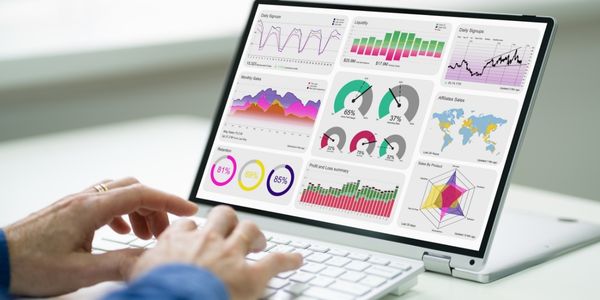Understanding How SQL is Used in Data Analytics for Effective Insights
By Erika Bronyah on 04/24/2025

If you want to pursue a career in data analytics, there are many skills that you need to bring to the job. Structured Query Language, or SQL, is one of them. As a data analyst, your primary job responsibilities are to collect, analyze and interpret data to identify trends and patterns. Those insights impact processes and business decisions.
What is SQL?
Structured query language is a standardized programming language for data relationships. Analysts and data programmers use SQL to store data, organize it and retrieve specific aspects of it. Basically, you can use SQL to ask questions about large banks of data.
It's a fair bit more complex than that in practice, however, since data stored poorly will skew anything you try to pull from it. Data analysis refers to the process of collecting, storing and using information to come up with useful insights—and it's only as good as what you put into it.
SQL is widely used in various industries, including finance, marketing, healthcare and more. In marketing, a data analyst uses SQL for customer segmentation and market research. If you choose a healthcare career path, you will use SQL for predictive analytics and report the best way to help a person with a pre-existing condition. In finance, SQL is necessary for data mining, reporting and business intelligence.
4 Ways to use SQL in data analytics1
Whichever industry they are in, data analysts mainly use SQL for these four functions.
- Retrieve and manipulate data from relational databases.
- Filter, store and aggregate data.
- Join multiple tables and analyze patterns.
- Create data visualizations and reports.
Examples of what SQL can do
A data analyst can work in many different industries doing a variety of different data manipulation responsibilities. Here are a few different projects a data analyst would use SQL to complete.
Customer behavior analysis
SQL makes it easy for analysts to query databases and retrieve relevant data. With queries, they can select only certain parts of large databases, and sort or filter according to one or many parameters. SQL queries can segment customers based on behavior, enabling targeted marketing strategies.2
Financial analysis
SQL is typically run to create reports and format data prior to its use in data visualization software. By querying and summarizing data, analysts can create datasets that are ready for visualization in tools like Tableau®, Power BI® or Excel®.
For financial analysis, analysts use SQL to monitor transactions, track financial health and detect fraud.2
Operational efficiency
SQL is used by analysts for data manipulation which includes operations such as altering records, adding new records and the removal of redundant records. This helps to keep the data as up-to-date and accurate as possible. SQL helps organizations optimize operations by identifying process bottlenecks and inefficiencies.
Types of SQL queries
A SQL query consists of three pieces, or blocks: the select block, the from block and the where block.
The select block tells the database which columns of data you want it to return. You must separate each column name with a comma.
There are several types of SQL queries, including SELECT, INSERT, UPDATE, and DELETE.3
A SELECT query is used to retrieve data from a database. An INSERT query is used to add new data to a database. An UPDATE query is used to modify existing data in a database. And a DELETE query is used to delete data from a database.3
Why use structured query language?
Learning SQL isn't as difficult as learning a foreign language, but it definitely has a learning curve. So, why bother?
If your company sent out a few surveys to a handful of customers, you probably wouldn't bother with things like a relational database and SQL. But when you work in data, you deal with a truly intense volume of information.
Consider a global e-commerce platform that tracks every purchase every customer makes, how much they spent, and how long the product delivery took. With hundreds of millions of purchases made each year, that platform is raking in an insane amount of data.
Without an efficient way to organize and understand that information, the data is useless.
Optimizing SQL knowledge and using SQL for data reduces the time it takes to retrieve and manipulate that data. When you perform data analysis using SQL data analytics it helps improve the accuracy and reliability of the key performance indicators.
To manage that large volume of data, analysts need to...
- Use meaningful table and column names
- Document SQL queries they make
- Test their SQL queries thoroughly
- Use clear and concise language when they query and report findings
- Avoid unnecessary complexity (things are complex enough as is)
- Use visualizations that effectively communicate insights
Following those best practices can help data analysts produce high-quality results and improve their productivity.
Common challenges in data analysis
As you can see, data analysis can be challenging due to the complexity of data transformation and volume of data.
Common challenges that come with data analysis include data quality issues, data integration challenges and scalability issues. Data analysts also face issues with complex SQL queries with multiple databases.4
Working in this field is interesting and full of puzzles to solve. For people who enjoy that kind of mental work, data analysis is never boring.
Optimizing SQL queries, leveraging data visualization and reporting tools on an SQL Server all come with their own challenges. Data analysts should also stay up to date with the latest powerful tools and technologies.
Would you enjoy how SQL is used in data analytics?
SQL is a powerful tool for data analysis that can help organizations make informed decisions and drive business growth. If you are looking into a career in data analytics, SQL would be an important skill to have. SQL is widely used in various industries and is an essential tool for data analysts and data scientists.
SQL is a key component of data science and business intelligence, and its importance will continue to grow in the future. If you're interested in learning more about a career as a data analyst, check out this article, Is Data Analyst a Good Career? 8 Things to Consider.
1Analytics Shiksha, (accessed March 2025), https://www.analyticsshiksha.com/blog/the-role-of-sql-in-data-analytics-features-uses-top-tools
2HubSpot, (accessed March 2025), https://blog.hubspot.com/marketing/sql-tutorial-introduction
3IBM, (accessed March 2025), https://www.ibm.com/think/topics/structured-query-language
4Oracle, (accessed March 2025), https://www.oracle.com/business-analytics/data-analytics-challenges/
Power BI® is a registered trademark of Microsoft Corporation
Tableau® is a registered trademark of SALESFORCE, INC.
Excel® is a registered trademark of Microsoft Corporation




